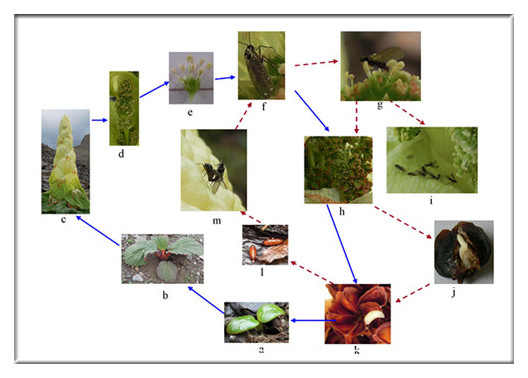
Researchers Find a New Pollination Seed-Consuming Mutualism in the High Himalayan
Jun 10, 2014 Email"> PrintText Size

Pollinating seed-consuming mutualisms are regarded as exemplary models for studying coevolution, but they are extremely rare. In these systems, olfactory cues have been thought to play an important role in facilitating encounters between partners.
Prof. SUN Hang’s research team from Kunming Institute of Botany (KIB) have been working since 1990s to understand how alpine plant survive and reproduce in harsh alpine environments. Although alpine plants usually experience pollinator limitation because of the low level of insect diversity, abundance and activity in alpine ecosystems, Rheum nobile (Polygonaceae), a perennial monocarpic herb with large and showy translucent bracts concealing the whole compound raceme, has very high fruit set (ca. 98%) in natural populations. This preliminary field observations revealed that flowers of R. nobile are frequently visited by seed-parasitic fly fungus gnats that lay their eggs in parts of the flowers. The study measured the seed production resulting from pollination by Bradysia flies and seed consumption by their larvae to determine the outcome of the interaction. In addition, floral scent analyses and behavioural tests were conducted to investigate the role of olfactory cues in pollinator attraction.
The results show R. nobile is self-compatible, but it depends mainly on Bradysia sp. females for pollination. Seed production resulting from pollination by adult flies is substantially higher than subsequent seed consumption by their larvae. Behavioural tests showed that an unusual floral compound, 2-methyl butyric acid methyl ester, emitted by plants only during anthesis, was attractive to female flies.
The results indicate that the R. nobile–Bradysia sp. interaction represents a new pollinating seed-consuming mutualism, and that a single unusual compound is the specific signal in the floral scent of R. nobile that plays a key role in attracting its pollinator.
These findings entitled “A new pollinating seed-consuming mutualism between Rheum nobile and a fly fungus gnat, Bradysia sp. involving pollinator attraction by a specific floral compound” were recently published on New Phytologist.

This figure shows that the life history of Rhuem nobile and pollinating seed-consuming fly (Image by KIB)
Pollinating seed-consuming mutualisms are regarded as exemplary models for studying coevolution, but they are extremely rare. In these systems, olfactory cues have been thought to play an important role in facilitating encounters between partners.
Prof. SUN Hang’s research team from Kunming Institute of Botany (KIB) have been working since 1990s to understand how alpine plant survive and reproduce in harsh alpine environments. Although alpine plants usually experience pollinator limitation because of the low level of insect diversity, abundance and activity in alpine ecosystems, Rheum nobile (Polygonaceae), a perennial monocarpic herb with large and showy translucent bracts concealing the whole compound raceme, has very high fruit set (ca. 98%) in natural populations. This preliminary field observations revealed that flowers of R. nobile are frequently visited by seed-parasitic fly fungus gnats that lay their eggs in parts of the flowers. The study measured the seed production resulting from pollination by Bradysia flies and seed consumption by their larvae to determine the outcome of the interaction. In addition, floral scent analyses and behavioural tests were conducted to investigate the role of olfactory cues in pollinator attraction.
The results show R. nobile is self-compatible, but it depends mainly on Bradysia sp. females for pollination. Seed production resulting from pollination by adult flies is substantially higher than subsequent seed consumption by their larvae. Behavioural tests showed that an unusual floral compound, 2-methyl butyric acid methyl ester, emitted by plants only during anthesis, was attractive to female flies.
The results indicate that the R. nobile–Bradysia sp. interaction represents a new pollinating seed-consuming mutualism, and that a single unusual compound is the specific signal in the floral scent of R. nobile that plays a key role in attracting its pollinator.
These findings entitled “A new pollinating seed-consuming mutualism between Rheum nobile and a fly fungus gnat, Bradysia sp. involving pollinator attraction by a specific floral compound” were recently published on New Phytologist.

This figure shows that the life history of Rhuem nobile and pollinating seed-consuming fly (Image by KIB)
CAS Institutes
There are 124 Institutions directly under the CAS by the end of 2012, with 104 research institutes, five universities & supporting organizations, 12 management organizations that consist of the headquarters and branches, and three other units. Moreover, there are 25 legal entities affiliated and 22 CAS invested holding enterprisesThere are 124 I...>> more
Contact Us

Chinese Academy of Sciences
Add: 52 Sanlihe Rd., Xicheng District, Beijing, China
Postcode: 100864
Tel: 86-10-68597592 (day) 86-10-68597289 (night)
Fax: 86-10-68511095 (day) 86-10-68512458 (night)
E-mail: cas_en@cas.cn

